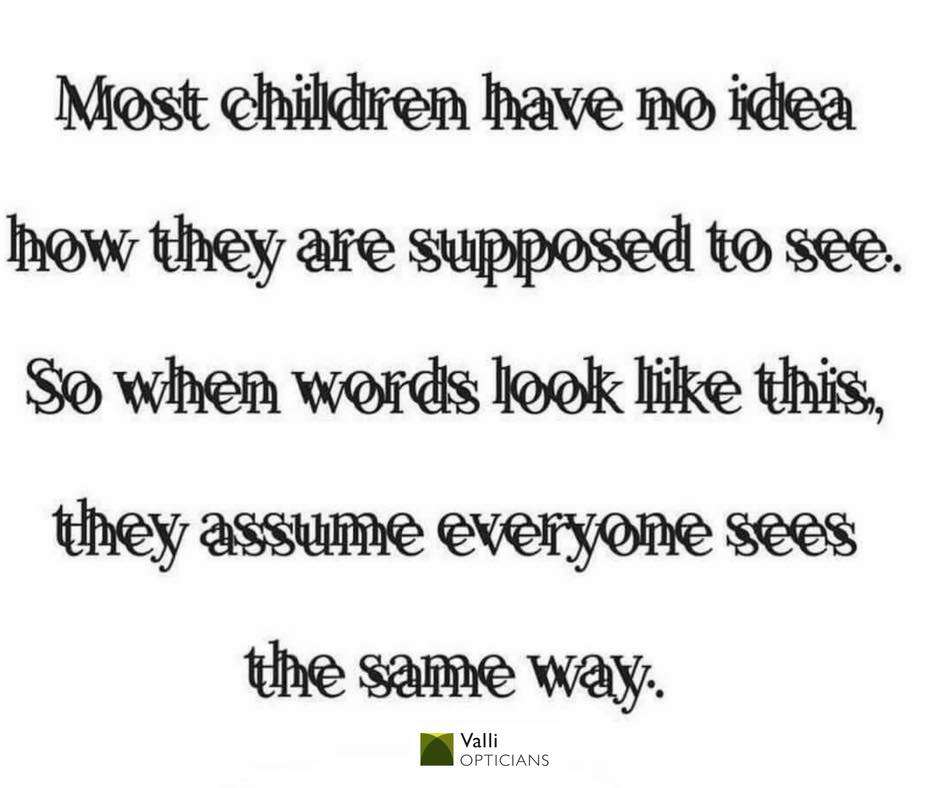What is Visual Stress? April 5, 2018 12:40 pm 

![]() by Sarah Duckworth, Optometrist at Valli Opticians Honley/Meltham in Huddersfield
by Sarah Duckworth, Optometrist at Valli Opticians Honley/Meltham in Huddersfield
As a local optician I often see children and young people who have visual stress. They don’t realise that the reason they are struggling to read is because they have this condition. It’s more common than most people realise with some estimates stating it affects 1 in 10 people, so in a typical classroom that is around 2 to 3 children.
However it isn’t only children who can have visual stress; it can affect adults too.
The good news for those with visual stress is that there are measures we can take to relieve the symptoms and help the child or adult to read better.
Visual stress is also called Meares-Irlen Syndrome or Scotopic Sensitivity Syndrome.
Simply explained, Visual Stress is a sensitivity to visual patterns, particularly stripes. In some individuals this condition can cause visual perceptual problems, which interfere with reading. The symptoms can occur despite normal vision.
One current scientific explanation is that the perceptual problems are due to a hyperactivation of the visual cortex of the brain, particularly in more anterior visual areas, which is reduced by precise individual colour.
Symptoms most commonly arise when someone with the condition is trying to read paragraphs of black text on a white background. This light reflected back from the page contains all the wavelengths of light in the visual spectrum. In visual stress, the brain is unable to process the full spectral of light. Using colour (overlays or tinted lenses) will selectively reduce the input of certain wavelengths of light and allow the brain to process visual information correctly.
What are the symptoms of visual stress?
Usually the simplest questions are the best and I find that asking a child the following: “Are you good at reading?” often identifies those that may have visual stress. If a child is behind their peers in their reading ability, or below their expected level at school, it is strongly advisable to look at the possibility of visual stress.
The really common symptoms apart from this are losing the place on the page when reading or getting letters jumbled up which leads to misreading words or text moving on the page.
Frustration and low self-esteem can occur in children who are underachieving due to visual stress. Early diagnosis of the problem is therefore essential in my view. The longer it takes to identify and remedy visual stress, the greater the loss of confidence that can result.
As an exhaustive list, all or some of the following symptoms may be present:
-
Words moving, blurring or going double
-
Letters changing size or shape
-
Patterns or halos of colour in text
-
Red, sore, watery eyes
-
Headaches when reading
Signs to look out for that may indicate visual stress:
-
Misreading text or reading words in the wrong order
-
Missing out words or whole lines of text
-
Losing the place on a page when reading
-
Tiring quickly when reading
-
Moving closer to or further away from the book
-
Moving the book around on the desk or fidgeting continuously
-
Using a finger as a marker on the page
-
Rubbing eyes or blinking frequently when reading
-
Poor comprehension of reading content
Some people may have all these symptoms but often people only suffer with one or two. It’s also harder for children to describe their symptoms or for them to know that what they’re seeing isn’t normal.
What are the treatments?
Visual stress symptoms can be relieved with the help of coloured overlays or precision tinted lenses in spectacles.
When visual stress is suspected, a sight test is carried out followed by an Overlay Assessment where a variety of coloured overlays are shown to identify the colour which most reduces the visual stress symptoms..
A Wilkins Rate of Reading Test is then carried out to assess if the coloured overlay improves the reading ability. If there is an improvement, this chosen overlay colour is prescribed to be used for reading over the next four to six weeks.
If using the overlay significantly improves reading, the next test we recommend is an Intuitive Colorimetry Assessment’. This allows precision tinted lenses to be prescribed in glasses, which is much better and a lot more convenient to use compared to a coloured overlay.
At this appointment the optician will find the exact hue (colour) and saturation (darkness of colour) that helps relieve the visual stress symptoms. This piece of equipment is able to prescribe from up to 100,000 colour combinations. Spectacle lenses are then tinted in this exact colour and used not just for reading but also for looking at computer screens and whiteboards at school and college. These lenses can also help relieve migraines too!
Is visual stress the same as dyslexia?
No. Dyslexia is a learning difficulty which causes the person with the condition to have problems with reading, writing, spelling as well as other things. People with dyslexia often suffer from visual stress and will benefit from overlays or tinted lenses but people can have visual stress but not necessarily be dyslexic.
Here at Valli we can diagnose and treat visual stress but not dyslexia. If a patient is diagnosed with visual stress and is struggling in other areas than just reading we would advise a referral to an educational psychologist for a possible dyslexia diagnosis.
How successful is the use of colour?
What I have described has been used for a number of years and found to be very successful.
The degree of improvement for each person differs however: some people experience improvements in reading age of one to two years within a few weeks of acquiring the lenses. In others, the lenses may offer greater comfort when reading, but the reading improvement may be less dramatic because of other reading difficulties.
Visual Stress is a perceptual processing condition that causes reading difficulties, headaches and visual problems from exposure to patterns in text, such as lines of text. Visual Stress is linked to dyslexia and similar visual learning difficulties. Sufferers experience print distortion and fatigue when reading.
Visual Stress is also known as Meares-Irlen syndrome, after the two researchers who first discovered the connection between white page glare and reading difficulties. The severity of these symptoms can vary from person to person, with approximately 20% of the population suffering to some degree.
Our specialist optometrists can help identify potential visual conditions including Visual Stress. Talk to us today about Visual Stress.
Research into Visual Stress
Scotopic Sensitivity Syndrome is another name for Visual Stress. Yet despite the research and many names for this condition, there is no proven scientific explanation, though scientists agree that Visual Stress is visual-perceptual in nature as a result of a deficiency in one of the visual pathways. Because of this, Visual Stress cannot be corrected by prescription lenses, can occur in people with 20/20 vision and can be very hard to accurately detect.
Using Colour Overlays
The causes of visual stress are currently unknown; there is no scientific explanation for the symptoms, however it is commonly agreed to be a visual-perceptual problem. Its perceptual nature means that it cannot be corrected with glasses as it is believed to stem from the visual cortex of the brain.
As it currently stands, the success of treatment for visual stress is debated. Research has come up with mixed results, with divided opinions on the benefits of using colour overlays on text. Presently some scientists believe colour overlays help those who experience visual stress and dyslexia. Interestingly, one study in 2005 found that 37.5% of children with dyslexia were affected by visual stress, whilst 25% of non dyslexic children were affected by it. There are those who believe dyslexia and visual stress are related in some ways.
According to a 1999 study by Evans et al, 80% of people who used coloured overlays on text found benefits from using them. Another study in 2001 found that children with dyslexia who were allowed to pick their own coloured overlay saw a reading speed increase of 25%. This has been argued however in a recent 2015 study whereby the author discredits the theory that dyslexia is caused by visual problems, meaning that coloured overlays will not reduce the symptoms. They suggest there was very little difference in performance of visual tests between dyslexic and non-dyslexic children.
Despite this, many people and children make use of coloured overlays when experiencing visual stress.
Different Coloured Overlays
It is commonly believed that a particular colour, hue and saturation will work best for each individual, i.e. an overlay that works for one person might not work as effectively for another. However, there appears to be no agreement on which coloured overlay works best as a whole.
What does this mean for treatment?
In essence, if a coloured overlay helps the symptoms of visual stress, the person affected is the best person to judge this. If no difference is experienced, they do not need to continue using them.
Sources
Irlen H. (1997). Reading problems and Irlen coloured lenses. Dyslexia Rev. Spring 4–7
Kriss, I. & Evans, B.J.W. (2005). The relationship between dyslexia and Meares-Irlen syndrome. Journal of Research in Reading, 28(3), 350–364.
Evans,B. J. W.,Patel,R.,Wilkins,A. J.,Lightstone,A., Eperjesi,F.,Speedwell,L. and Duffy,J. (1999) A review of the management of 323 consecutive patients seen in a specific learning difficulties clinic.
Wilkins, A.J., Lewis, E., Smith, F., Rowland, E., & Tweedie, W. (2001). Coloured overlays and their benefit for reading. Journal of Research in Reading, 24, 41 – 64.
Symptoms of Visual Stress
Symptoms of visual stress are not immediately obvious. Many people who suffer with this syndrome believe the discomfort they feel when reading are normal and experienced by everyone.
- Headaches
- Eyestrain
- Tiredness after reading
- Blurring or movement of print
- Letters changing size
- Illusions of colour on the page
Symptoms
Moving Text
When reading, you may find that text moves around the page, jumps around or even disappears. It can also appear to swirl around and blur, making it incredibly difficult to focus on the text.
Letters Morphing
Another symptom in addition to text moving around is the morphing of text. Text can change size or shape and you may experience letters getting darker or fading away.
White Background Becomes the Focus
This symptom involves the reader seeing ‘white rivers’ or ‘worms’ winding throughout the words of a page. This is due to the focus being on the background over the black text.
Random Colours Appearing
You may experience rings or blobs of colour surrounding text on a page.
Physical Discomfort
Sufferers may find they get tired quickly when reading and get headaches or migraines. They may also experience sore, watering eyes that are visibly red.
Aside from the symptoms that occur when reading text, someone that experiences visual stress may find they also have these more generalised symptoms:
Sensitivity to Bright Light
Those who suffer from visual stress can find bright lights, fluorescent lights in particular, extremely uncomfortable to be around. This extends to bright, reflective surfaces, interactive whiteboards and any other high contrast surfaces.
Distorted Depth Perception and Spatial Awareness
If you have visual stress, you may find it difficult to judge distances and space around you.
Signs of Visual Stress in Children
Early identification of Visual Stress and treatment could save years of anxiety in children and prevent the loss of confidence and quality of learning that occurs in most cases where children struggle to read.
While visual stress has no scientific explanation, there are a number of generally agreed upon signs of Irlen Syndrome. While symptoms vary, sufferers of Visual Stress commonly experience headaches, eyestrain and experience words to jump or move on the page.
- How to tell if your child suffers Visual Stress
- Signs of Visual Stress in children while they are reading include:
- Moving closer or away from the page
- Becoming restless while reading
- Using a finger or other item as a marker
- Skipping words or lines
- Rubbing of eyes
- Excessive blinking
In young children, you should keep an eye out for external signs that they are suffering Visual Stress.
Frustration and low self esteem can occur in children who are underachieving due to Visual Stress. The longer it takes to identify and remedy visual stress, the greater the loss of confidence that can result.
- General signs of Visual Stress include:
- Low self esteem
- Unusual sensitivity to bright lights, especially fluorescent lighting
- Headaches and migraines when reading
- Difficulty looking at a computer screens
- Difficulty judging heights or distances
- Things to ask your child
Here are some questions that may be helpful to ask your child:
- “Do the letters stay still or do they move?”
- “Are the letters clear or are they fuzzy/blurred?”
- “Is the page too bright, not bright enough or just about right?”
- “Does it hurt your eyes to look at the page or is it OK?”.
- “After you have been reading for a while, do the words or letters do anything different?“
It’s important to keep an eye out for signs of Irlen Syndrome in children, as it can have a big impact on their ability to learn and engage with the written word. If noticed early, you can take steps to alleviate the condition. The sooner you can take steps to combat Visual Stress, the less negative impact it will have on your child’s development.
Visual Stress and Dyslexia
Dyslexia is a general term for disorders that involve difficulty in learning to read or interpret words, letters, and other symbols. It does not affect general intelligence, just the interpretation of data on a page. Due to the fact that 80% of our education is visual in nature, dyslexia is sometimes assumed to relate to intelligence. If Visual Stress is identified and colour is used to alleviative some of the symptoms then other learning difficulties such as dyslexia are easier to cope with.
Visual Stress is not dyslexia but is prevalent in dyslexic individuals. Even so, a significant percentage of children and adults who are not identified as being dyslexic still suffer with symptoms of Visual Stress.
Visual Stress Test
If you have any concerns surrounding your child and visual stress, start by having a go at this simple Visual Stress Test before getting in touch with a member of our Eyesite team.
Can You Treat Visual Stress?
Coloured lenses assist sufferers of Visual Stress with reading. They help remove any glare the person receives from the page, reduce fatigue when reading and increase reading fluency and comprehension. Some say that the colour of the glasses is dependent on the individual and may change over time. This is why it is important to receive an individual specialist assessment from a professional.
Treatments for Visual Stress
If you are suffering from Visual Stress or have a child displaying the symptoms, visit Eyesite today. Our specialist optometrists can help identify potential visual conditions including Visual Stress.
Get In Touch



